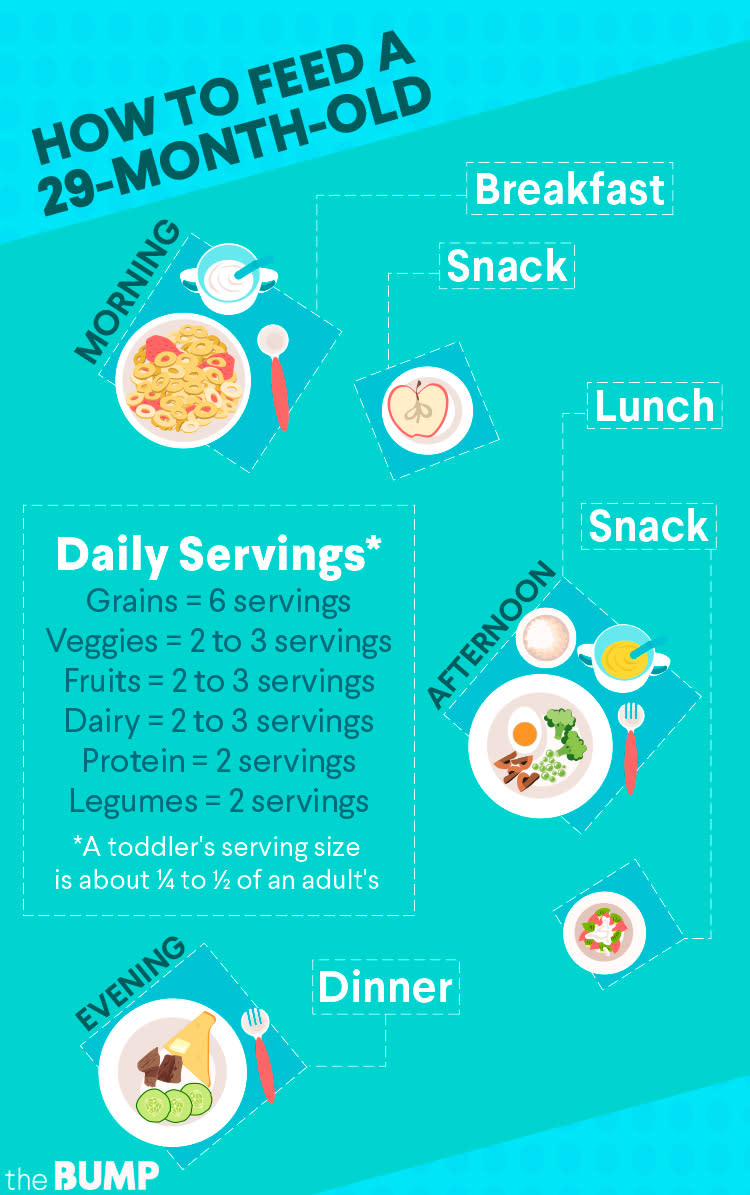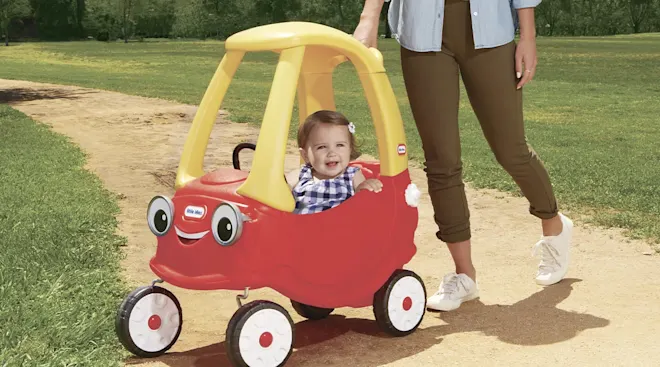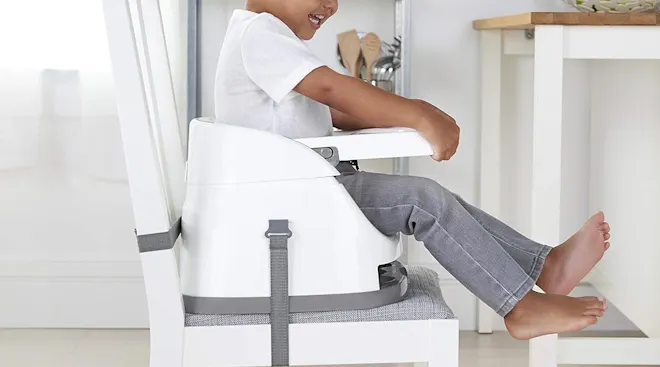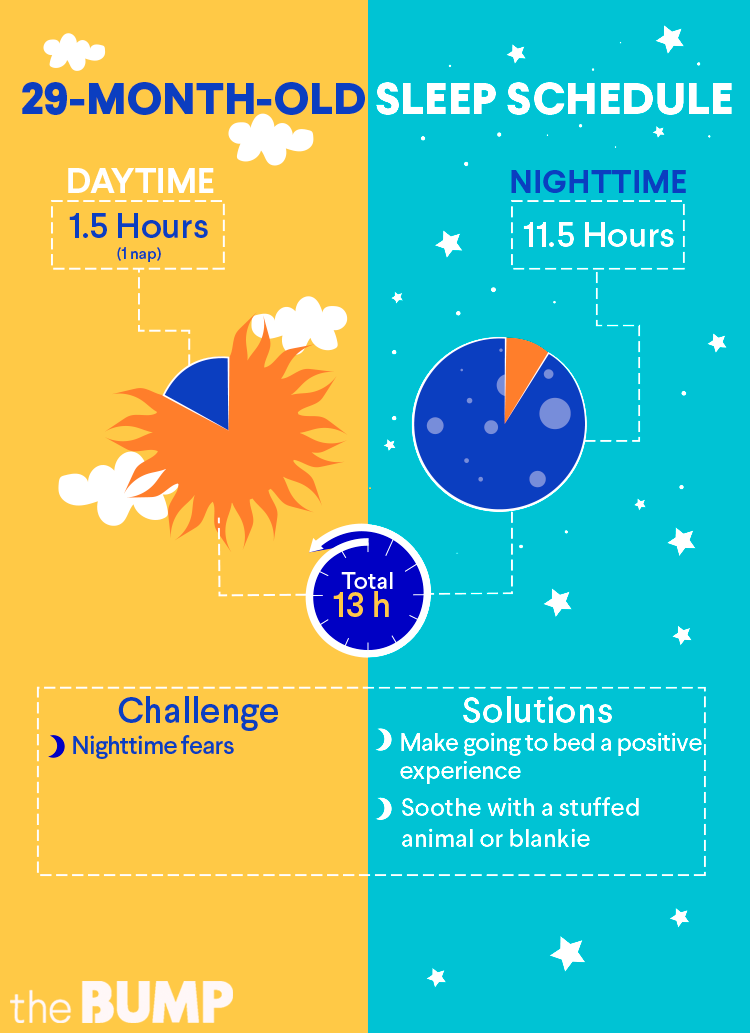Your toddler is 29 months old! Between the ages of 2 and 3, kids exhibit a language explosion; their vocabulary undergoes massive expansion and they begin to understand its nuances. For example, your kiddo may have started using pronouns like “I” or “me.”. That’s a huge cognitive leap! Encourage your child's language development by reading to them (rhythmic and repetitive stories are a huge hit right now), sing together and chat while you play.
What other 29-month-old milestones can you expect? There are quite a few! We’re here to reveal what you can look forward to during this next month in your child’s life, and offer sleep routine advice, creative meal ideas and tips and tricks for raising a happy and healthy toddler.
As your 29-month-old grows, they're learning tons of new skills.
29-month-old weight and height
Average weight for a 29-month-old is around 28.4 pounds for girls and 29.6 pounds for boys. Average height is around 35.3 inches for girls and 35.7 inches for boys, according to the US Centers for Disease Control and Prevention (CDC).
29-month-old milestones
Many parents wonder, “What should my 29-month-old be doing?” A lot is going on in your 29-month-old’s life right now as they continue to grow and develop each day. Your toddler is likely hitting (or working toward) these 29-month-old milestones:
- Speech. Your 29-month-old may be speaking in sentences, but they probably aren't perfect sentences. For example, "Me jump big!" Try repeating what they’re saying in a grammatically correct way instead of pointing out that their grammar is wrong. ("Yes, you did jump so high!") A 29-month-old who’s not talking should get an evaluation from a pediatrician. Sometimes, the child is communicating and just needs more time to get the words right. Other times, they need a little help from a speech specialist.
- Getting dressed. Your child can probably put on at least one piece of clothing by themselves—which is welcome news, after having to put every single article of clothing on your kid for almost two-and-a-half years.
- Potty training. Know how kids learn to use the potty? By having accidents! So if you're potty training, instead of getting frustrated whenever your kid wets their underwear, think of it as one step closer to learning how to keep them dry. Encourage and praise when things go right.
- Teething. Your 29-month-old child may be teething with their second molars. Also known as the 2-year molars, these pearly whites tend to erupt between 23 and 33 months. And since they're big, it can be a painful process. The good news is they're the last teeth to come in until around age 6, when kids can better deal with the discomfort, so soon, you'll be done with teething woes.
29-month-old behavior
- Whining. Even if your child is highly verbal, they don't have all the words and phrases that you do, so they might rely on whining to get their point across. Don’t let your kiddo get what they want by whining; that just encourages more of it.
- Moodiness. Your child gets cranky when they're hungry or tired, so don’t plan anything demanding (like a playdate or trip to Home Depot) close to naptime or for when they haven't eaten in a while.
- Repetition. Your child may have favorite shows, clothes and books they want to read over and over.
Health is always a top concern for parents, and this age is no different. Some common health questions parents of 29-month-olds have are:
- My 29-month-old has diarrhea. What should I do?
- My 29-month-old is constipated. What should I do?
- My 29-month-old is throwing up. What should I do?
- My 29-month old has a cough. What should I do?
- My 29-month-old has a fever. What should I do?
When it comes to food, as usual, it's all about balance. Sure, it's okay to let your kid have those fruit snacks or an occasional Oreo or two. But balance that out with some apple slices and thin carrot sticks.
How much should my 29-month-old be eating?
Two-year olds should continue to eat three meals per day, plus one or two snacks. Offer a variety of foods in all food groups—vegetables, fruits, grains, protein and dairy—daily. Portion size isn't big at this age: Expect your kid to eat only ¼ to ½ as much as an adult.
Your 2-year-old should be drinking 1 percent or skim milk (not whole milk). Try to offer low-fat dairy products too, such as yogurt and cheese. Doctors recommend kids ages one to 3 get 700 mg of calcium per day. Fat should account for less than 30 percent of your toddler's daily calories.
What to feed my 29-month-old
Looking for some tasty and nutritious meal inspiration? Check out these food ideas for a 2-year-old:
29-month-old feeding schedule
29-month-old eating problems
Young kids tend to be picky eaters. They like to load up on sugar and fluids and may avoid the fats and proteins they need. This can result in a condition called toddler's diarrhea, in which the child gets loose, watery stools—but isn't otherwise sick—for several days straight. Prevent this condition by limiting your kid's juice intake and offering foods with plenty of fats, protein and fiber. Fresh fruits and veggies are super-important.
At 29 months, the experts say your child should have a sleep routine, but you never know what's going to come up next: demands to stay up late, refusal to take a nap and even maybe some new nighttime fears. It can all throw you for a loop. But eventually, you'll all get back on track.
How much sleep does a 29-month-old need?
Most 2-year-olds need around 11 to 12 hours of nighttime sleep, plus a nap of about 1.5 to 3 hours, for a total of about 13 to 14 hours of sleep per day.
29-month-old sleep schedule
Every kid is different, but your child's schedule may look something like this:
29-month-old sleep problems
Some 2-year-olds develop nighttime fears. Sticking to that soothing bedtime routine—free of anything potentially scary or stimulating—can help make going to bed a positive experience. It's okay to indulge your kid a bit and turn on a night light or keep the door open a crack. Give your toddler a comforting stuffed animal or blankie and reassure your child that they're safe and you're there, even when they can't see you. Some parents fill a spray bottle with water and tell their child it's a special monster repellant they use every night at bedtime. Eventually, your child will grow out of their nighttime fears—it just may take a while.
Your active 29-month-old just wants to have fun. Through play, they’re learning every step of the way and developing their motor skills and creativity. So what to do with a 29-month-old? Some fun activities, games and toys for a 29-month-old include:
- Singing. They love simple sing-along songs—and if the song has accompanying motions (think "Itsy Bitsy Spider"), all the better.
- Dancing. Play a few favorite kid-friendly songs from your playlist. Your 29-month-old probably digs a good dance party.
- Outings. Children's museums, zoos, kids' gyms, libraries, bookstores and aquariums are all fun places to take a 29-month-old.
- Cook or bake together. Your child can help with the safe parts—i.e., the ones that don't require knives and heat.
- Beat frustration by teaching independence. Instead of telling your kid which puzzle piece goes where, help a little, and make sure they're the one to place the last piece. That will give them the confidence to try again next time.
- Teaching your child to share can take a long time. It helps for parents to model what sharing looks like and to praise their child when they make an effort to share too.
- Some 2-year-olds develop a fear of the water, which can make bathtime a challenge. It may ease your kiddo's anxiety to stick to a really low water level, give them fun toys and bubbles or even get in the tub with your kid. When all else fails, try a shower instead.
- Your 29-month-old is beginning to remember things, whether that’s something that happened yesterday or a visit to Grandma’s house last week. Encourage your toddler to recall events and routines to help them exercise their memory. Ask your child what they ate for lunch that day or what step comes next after brushing their teeth each evening.
- If you haven’t done so already, it’s important to toddler-proof your home. Remember, toddlers love to climb and get their hands into everything. Make sure dressers and bookshelves are properly secured to the wall, and keep your 29-month-old baby away from anything sharp like scissors and knives.
- Repetition is a huge aspect of a toddler’s life right now because it provides them with a sense of comfort and control. You may find your 29-month-old baby wanting to eat the same food, wear the same clothes and say the same things every day. While developing a routine is good, it’s important to show your toddler that change is okay too.
- Don’t be surprised if whining becomes a new thing in your home. Whining is to toddlers what crying is to babies—that is, it’s often a way they communicate frustration. While it’s sometimes unavoidable, do your best to discourage the behavior and encourage your 29-month-old to use their words instead. Letting your child get their way by whining will only perpetuate the problem.
- Looking for new ways to discipline your toddler? Whatever you do, don’t take away (or threaten to take away) your child’s comfort item, whether that’s a favorite blanket, stuffed animal or doll. These special belongings provide a sense of security, and removing them can cause an even bigger issue in the long run.
- Consider browsing preschools to find a 3-year-old program that might be a good fit for your child. Visit schools and talk to other parents, but don’t wait until your child reaches the three-year mark to start your research, as it can be a long and arduous process.
As your toddler hits their 29-month-old milestones, you will likely begin to feel as if you have a true big kid on your hands. Each new day brings exciting developments as they interact and engage with you and the world around them.
Please note: The Bump and the materials and information it contains are not intended to, and do not constitute, medical or other health advice or diagnosis and should not be used as such. You should always consult with a qualified physician or health professional about your specific circumstances.
Navigate forward to interact with the calendar and select a date. Press the question mark key to get the keyboard shortcuts for changing dates.















































